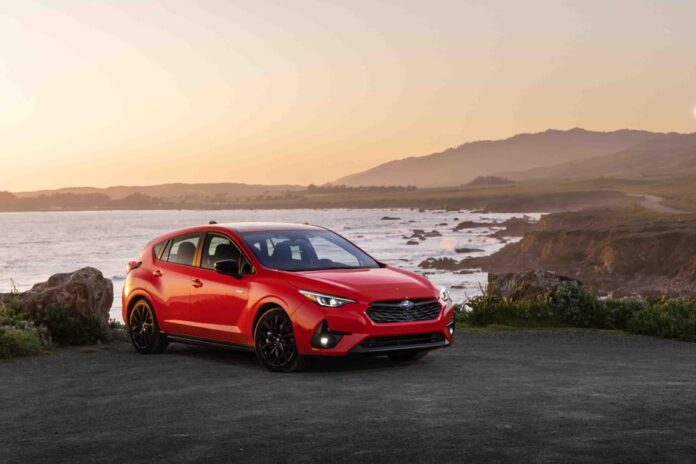At Subaru, we decided to revive the Impreza RS, which first appeared more than 25 years ago, with the aim of preparing the ground for the arrival of the WRX and WRX STi. Reintroduced in the spring, is this acronym also intended to announce the return of the WRX STi to the catalog? Don’t believe it!
No, the RS does not foreshadow the return of the WRX STi (with a gasoline engine, of course). Rather, it is returning to service to restore glamor to the Impreza family by highlighting not so much the style or sophistication of a model as its performance. Which may seem quite schizophrenic, when speed is no longer a rising value. However, there are still drivers fond of this more pungent type of seasoning. This nostalgia sequence is primarily aimed at the generation of those who, in the 1980s and 1990s, were immersed in the myth of the Volkswagen GTI at a very young age. Customers who, today, belong to the socio-demographic category in which most new car buyers are recruited.
The RS acronym is pinned to a car which is certainly no longer quite a youth, but which nevertheless benefits from many developments. The most notable of course is the integration of the 2.5L engine under the hood. A large displacement, but which translates into an increase of only 30 hp and 33 lb-ft of torque compared to the 2.0L engine that equips the rest of the range (see our boxes). But the main gains here affect the sound level.
That said, this mechanic packs enough punch when entering a fast lane or performing an overtaking maneuver. But the clock doesn’t lie… The competition is faster and, even better, more economical at the pump if you don’t take the drive mode into account. Indeed, a Mazda 3 Sport equipped with the naturally aspirated 2.5L engine and all-wheel drive consumes just as much as the Impreza RS, which also benefits from a larger fuel tank this year. But it uses a continuously variable box (CVT) technically supposed to be more sober. Mazda uses a traditional automatic transmission and it’s much nicer than Subaru’s proposal. And this, despite all the attention it receives this year. Alas, RS or not, all Imprezas are dropping the manual transmission as part of this partial redesign.
Notwithstanding these flaws, this RS with its perfectly tuned chassis is completely trustworthy. The precision of its steering, the specific adjustments made to the shock absorbers and springs, as well as the four-wheel drive technology give it reassuring road qualities in all conditions. On wet or, even better, snowy roads, it’s not the sporty handling or mechanical performance of the Impreza RS that stands out, but rather its stability.
Remarkably balanced, this car lets itself be guided with great finesse and precision thanks to a steering which offers the right amount of firmness to provide good sensations. Traction is never lacking and the rear axle rolls up well, which allows it to be easily entered into tight turns. All this contributes to the feeling of safety that one feels at the wheel. The increased rigidity of the chassis limits body movements and allows the suspension to soften a little so as not to sacrifice comfort. This Subaru turns flat and short, and only the tight turns taken at (very) fast speed reveal the lack of grip of its tires and the compromise of its connections to the ground which are somewhat gentle on our vertebrae.
With the RS, having a good time behind the wheel becomes an accumulation of tiny joys, made up of furtive acceleration, delicate “touch of the road”, simple pleasures.
We slip into the controls of this RS or any other Impreza without any problem. The front buckets wrap you properly and are comfortable over long distances. After making the necessary adjustments to achieve a pleasant driving position, the eye and the hand are flattered by the too few sporty elements grafted into the cabin. In addition, the presentation is austere and it would be even more so, had it not been for the two-tone treatment of the seats or the topstitching. The dashboard shell houses rather poor instrumentation for a car with a sporty accent. The quality of the materials is correct, nothing more, but it is – again – the seriousness and the robustness of the finish that catches the attention.
From $26,795 to $34,795
8.9 L/100 km (manufacturer data)
Feeling of safety Greater autonomy (tank) Improved soundproofing
Consumption (2.5 L) CVT gearbox, the only choice Austere presentation
Slightly more expensive, the WRX offers much more sensations.
La Presse will soon publish the test of the following vehicles: Ford Mustang, Hyundai Kona, Mercedes Class E and Volkswagen Atlas. If you own one of these vehicles or are waiting for delivery, we would love to hear from you.















